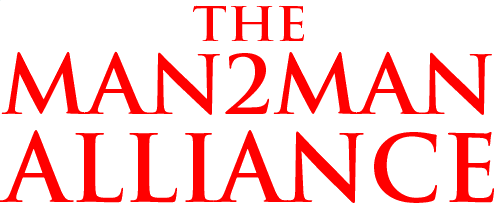


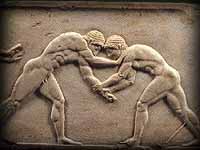

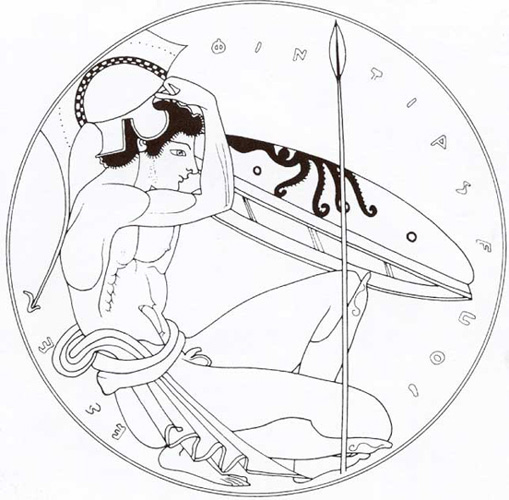
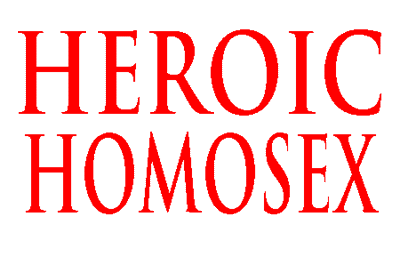

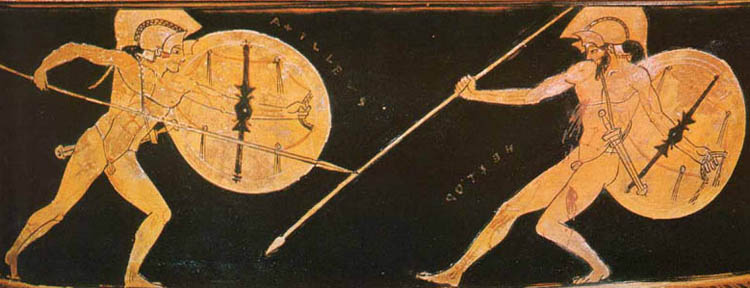

Bill Weintraub
Preface
Heroic Homosex -- The Greeks consists of both text and images. You need the text to understand what you're seeing, but I hope too that you'll really look at the images -- for a while -- hang out with them and reflect on what they mean.
Cause for one thing, we're fortunate to have them. Of course most Greek art was destroyed, but we still have a lot -- and what we do have speaks volumes about Greek culture and Greek homosex.
But the main reason that I encourage you to spend time with the images is that they challenge our most basic assumptions about homosex and masculinity. They treat homosex not as a perversion, but as a completely masculine activity that's integral to a warrior ethos.
That's not the same thing as gays in the military. It's not even close. Gays in the military is a policy of tolerance toward a deviant minority.
Whereas Greek warrior homosex -- Heroic Homosex -- is an expression of the deepest values of Greek civilization.
Sometimes bloody, sometimes beautiful, sometimes both.
But very, very different from our own idea of m2m.
For that reason, spending time with these images is liberating, and the more time you spend, the more liberated you'll become.
Cause you'll realize just how arbitrary and confining our own culture's view of homosex is.
And how ennobling was that of the Greeks.
And, that, thanks to the Greeks and other warrior cultures, we can see that we have a choice.


Part I

Hoplites were the heavily armed Greek infantrymen of their day. They're significant to our discussion because the rise of m2m eros in ancient Greece and the development of a new military tactic known to historians as the hoplite formation coincided, as did nudity in athletics, the palestra or wrestling school, and all-male communal messes.
Unlike previous military strategy, the hoplite formation emphasized teamwork and discipline among members of military units, and required an extremely tight bond between warriors.
The hoplite flourished from about 650 BCE to 323 BCE, as did homosex.
In Hoplites I present more than 40 different images of hoplites and non-Greek warriors with a discussion of tactics, the importance of the warrior bond, the ritual aspect of Greek warfare and its relationship to m2m, the connection between nude athletics and training for war, morale issues, and nudity in battle.
The key constituents of Greek homosex all appeared in the mid-7th century BCE, at the same time that a change in military tactics revolutionized combat and changed forever the face of war.
That revolution is called the Hoplite Formation.
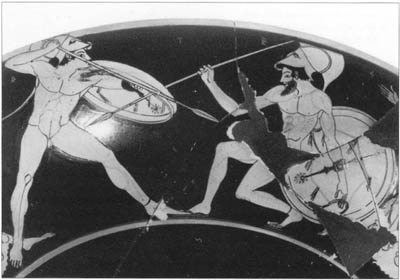
|
memnon's first spear thrust has been caught by achilles' shield achilles will kill him with a single blow |
In the Iliad, the best record that we have of warfare in the Dark Age that preceded by some 500 years the flowering of the Greek city-state, war is almost always a matter of one-on-one combat. Most often, the warrior is driven to the battlefield in a chariot, almost like he's taking a taxi to the office, and there he looks for an opponent with whom he first exchanges taunts and then blows. The number of blows struck is very small. Usually one of the antagonists is disabled or killed in the first or second thrust of a spear or sword, and falls to the ground, leaving the victor to fight for the spoils, his foe's armor and sometimes the body itself. There's little in the way of tactics, and when there's a coordinated attack, it swiftly becomes a free-for-all rather than a disciplined advance.
500 years later, half a millennium after the Greeks had sailed forever from the shores of looted Troy, warfare evolved, ceased to be a matter of individual combat, and instead became a function of discipline and order.
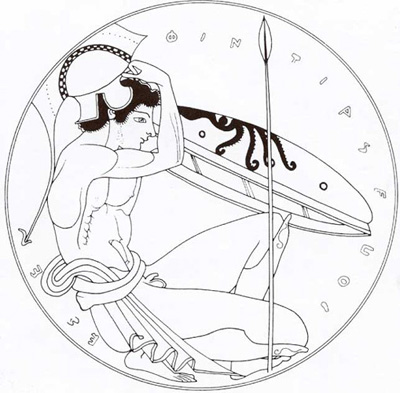
|
helmet, shield, spear, greaves breastplate and sword optional often nude |
Every soldier - that is, every hoplite, the heavily armed Greek infantryman - had the same equipment: a helmet, sometimes a metal breastplate or leather cuirass to protect his torso, and greaves to guard his lower legs. In his left hand he held a round shield made primarily of wood, while in his right he carried a spear. And from his shoulder hung a sword as well.
Rather than going individually into combat, these hoplites stood tightly shoulder-to-shoulder, positioned so that the shield of the man on the right protected the spear hand of the warrior on his left. This line of soldiers, grouped with others in orderly rows in a phalanx, advanced in lock step toward the opposing line. No individual could stand up to such a formation. Instead, the antagonists organized into a similar line, and marched forward until the two armies collided violently, with a force so great that shields often buckled from the impact. While the front lines stabbed furiously at each other in what contemporaries described as a "storm of spears," the lines of soldiers behind pushed forward those in front, and what ensued was basically a shoving match, until one line gave way and the other simply cruised over its remnants.
Victory was dependent upon preserving an unbroken line, and so it was crucial that during that storm of spears and violent collision of shields hoplites remain, as Sophocles said, "true and noble standing at each other's side." For once the line was broken, it was easily defeated, as it disintegrated into individual soldiers who could be pursued and killed. But an unbroken line was unstoppable, and could move forward over the battlefield crushing all opposition.
So cohesion was paramount. The single most important act in war was to stand tight with your fellow warrior, to be so bonded with him that nothing would make you leave his side.
Here are two images that may help you better visualize the formation:
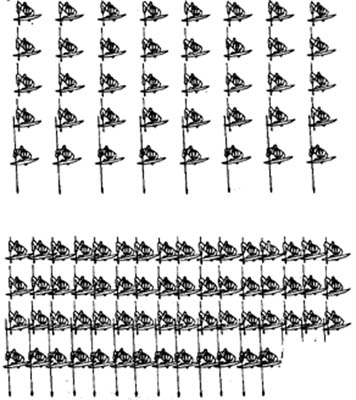
|
an aerial view |
In this schematic aerial or bird's-eye view of the hoplite formation, the soldiers' spears are in attack position, pointing toward the bottom of your computer screen. The top five rows of soldiers are grouped relatively loosely so that they can advance. The bottom four rows have come together in a tight formation to make or withstand an attack.
As you can see, so long as the soldiers stand tightly shoulder-to-shoulder and shield-to-shield, the line is impenetrable - there's simply no way to get through it, and any individual who attempts to stop it will be killed.
Conversely, if the line begins to give way - if just one soldier wavers - the opposing line can force its way into the gap, gaining a tremendous advantage, and can then easily crush the opposition.
This formation was so formidable that very often battles didn't happen - if one line of soldiers judged its opposition unbeatable, they would just abandon the field.
It was the hoplite formation that stopped the Persians in 490 at Marathon and then again in 480 BCE at Thermopylae. The Achaemenids weren't prepared for it, and though they vastly outnumbered the Greeks, they couldn't beat it.
Similarly, it was Sparta, more than any other Greek city-state, which perfected the use of the hoplite formation, and so held supremacy in land warfare for 200 years. The Spartans drilled incessantly. And in addition, the Spartan system of warrior training, called the agogé, inculcated a shared warrior mentality and created an atmosphere of fervid m2m eroticism that kept the hoplite bonds at a level of ferocious intensity
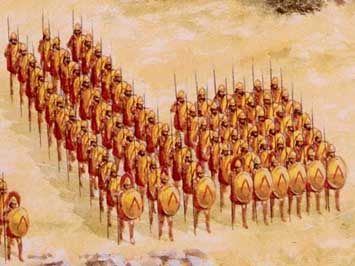
|
spartan battle drill |
In this second illustration, an artist's conception based upon a passage in Xenophon's Memoirs, we see the Spartans drilling.
The men on the far right are in a tight hoplite-formation phalanx -- they need only lower their spears to be ready to receive an enemy attack.
The men on the left are also in formation, but placed more loosely, so that they have greater freedom of movement.
Through incessant drill, the Spartans gained the ability to modify their formations quickly. That's what made them so dangerous.
That, and the strength of the erotic bonds between warriors, which meant that the lines simply would not give way. When, in 371 BCE, the Spartan line was finally broken, it was by another erotically bonded military unit, the Sacred Band of Thebes.
It's important to understand, in considering the hoplite formation and the terrain of Greece, just how ritualized Greek warfare actually was. Greece is a mountainous country, well-suited to guerilla tactics - but the formation only worked on open plains.
Yet the Greeks stuck to it doggedly. And though they did use ambush and other guerilla methods on occasion, to them the ideal test of strength between two armies was the clash of phalanxes.
It is a striking fact that the key constituents of institutionalized m2m eroticism in archaic Greece all emerged at the same time as the hoplite formation: nudity in athletics; intensive military training, often nude also; the palestra or wrestling school; and the all-male dinner party or communal mess (which had different names in different places - for example, the symposium in Athens, the phidition in Sparta, the andreion on Crete).
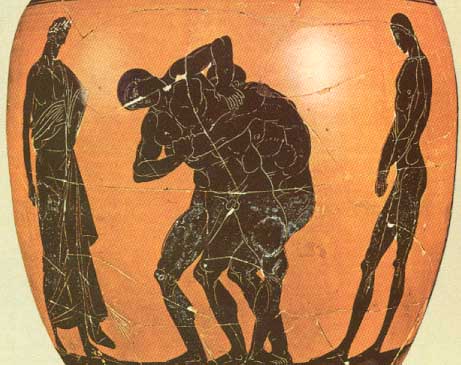
|
the referee is on the left on the right is the handsome youth who will wrestle the victor |
Nudity in athletics was celebrated at the four great pan-Hellenic games, but in addition all Greek males exercised nude. Early on every city state founded a palestra or wrestling school, where, in the afternoons, men and youths of the citizen class would meet to exercise, wrestle, socialize, and look for romantic partners - nude. This nudity was not a small matter to the Greeks. They considered it the mark of a civilized man, and would have been ashamed to wear clothes in an athletic setting.
At the heart of Greek athletics was the one-on-one contest, the individual's strenuous physical struggle to gain victory over his opponent. That's why, at the four great pan-Hellenic games and even smaller local contests, boxing was included and team sports or events aimed only at setting a record were excluded. It's also why the Greek pentathlon - long jump, sprint, discus, and javelin - culminated in wrestling. As is plain from their word for contests, agones, to the Greeks athletics above all meant the struggle, competition, and pain experienced by one man attempting to defeat another.
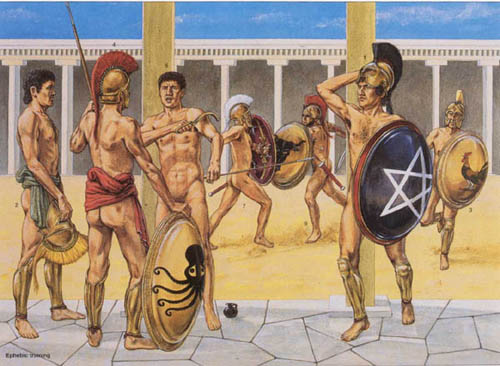
|
the view is from the apodyterium or undressing room |
Intensive military training also took place at the palestra, though over time other facilities (which we would call parade grounds) were developed for drill. Still, it was common for Athenian ephebes (the word ephebe is ambiguous - it can mean athlete or teen-ager, but in Athens it denoted youths 18 to 20 years old who underwent compulsory military service) to train, nude, at the palestra.
And of course all of a Spartan male's life from the age of 7 to 30 was occupied by the agogé, an intensely communal and erotic form of warrior training, in which nudity was almost constant. (We explore the agogé more fully in A Nation of Heroes: State-Education in Sparta -- and other articles in the Agogé series listed in the Heroes Site Guide.)
All-male communal messes took different forms in different cities. In Athens for example, men would gather at symposia, all-male dinner parties, elaborate and ritualized, of which Plato has left the most famous record. In Sparta, all men belonged to and ate in communal messes or eating clubs called phiditia, which were supported through member dues. The phidition was without question the most important affiliation in an adult Spartan male's life - a man who for some reason couldn't afford the dues at his phidition was disgraced and in a sense homeless. On Crete, to take yet another example, men ate communally at the andreion, which seems to have been similar to the men's lodges or long houses present in many primitive warrior societies.
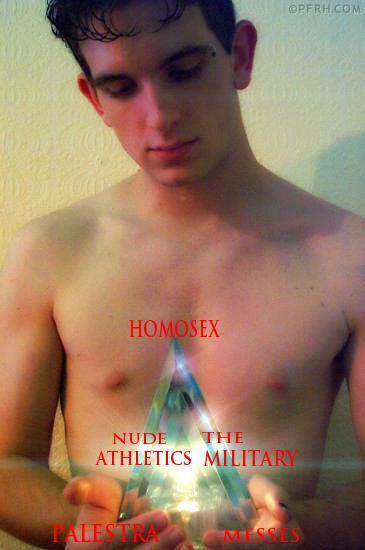
|
One way to conceptualize these elements is to think of Greek homosexuality as a pyramid, with homosex at the apex and nude athletics, the military, the palestra, and the symposium making up the four sides of the base. Each then plays into the other. For example, nudity in athletics both contributed to and was a function of homosexuality. The same is true for the military, the palestra, and the communal messes. Each of these institutions both supported and was supported by homosexuality, and in the aggregate they made for a very stable social order.
In addition, there were subtle interactions and continuities between the individual elements. For example, athletic training, done nude, was a precursor to military training, also done nude. Both were conducted at the palestra, a place where males not only exercised and trained but looked for potential romantic partners as well. The erotic bonds formed by those partners, which were reinforced at all-male dinner parties and communal messes, served to strengthen the military bonds.
And Greek artists and writers in turn become propagandists for homosex, creating homosexual love lyrics, statues of heroic and beautiful youths, homoerotic vase paintings, philosophic treatises, and reworkings of Greek myth that provided the Olympian gods and culture heroes with lovers and devoted male companions.
Now it can be debated to what extent homosex, which I've put at the top of the pyramid, was seminal and determinant to its other parts. The Oxford Classical Dictionary, for example, states that the four distinctive attributes of classical Greek culture were athletics, the palestra, the symposium, and homosexuality. (And, I would add, war.)
But if we look at the first three, we can see that homosexuality, and indeed a martial and rigorously masculine homosexuality, was in fact the decisive element in giving each institution its defining characteristics.
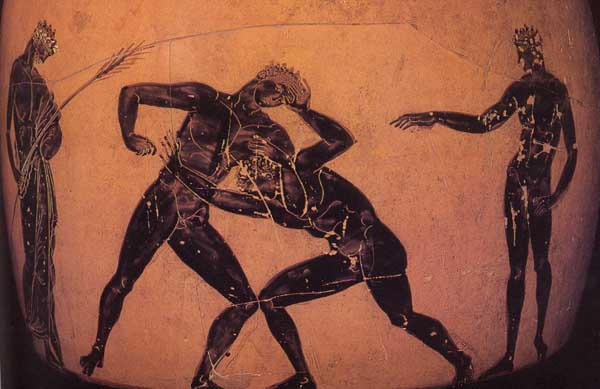
|
the ultimate greek contest |
Athletics were practiced nude because of homosexuality, and the Greek ideal of athletics, which as I've said was one man's hard-fought physical struggle against another for victory, and which excluded therefore team sports, was in its essence homosexual. Both the palestra and the various pan-Hellenic games, which had their foundations in religion, existed so that men could both experience and witness this nude male athleticism in its most strenuous forms, culminating in the ultimate male agones of wrestling, boxing, and the pankration, an almost no-holds-barred mix of wrestling, boxing, and kick-fighting. The symposium and the all-male communal messes also existed in the service of homosex, in Athens a particularly intellectualized and, under Plato, spiritualized form of homosex, but in most places a more openly carnal and military one.
So while there was a constellation of activities, all interacting, homosex retained a seminal and dominant role.
And I think that's true of even the hoplite formation. While some might wish to put the hoplite formation itself at the apex of the pyramid, the fact is that nude athletics and all-male messes were not necessary to that tactical advance. But homosex was, in the sense that it strengthened the hoplite bonds, and was described by writers like Plato as a major motivator for men to behave "honorably" -- that is, to not run away or otherwise break the line.
Indeed, homosex was core to the phiditia and andreia and symposia and the Olympics and other sacred games -- and, in point of fact, the most striking features of Greek society in the archaic and classical periods (for our purposes from 650 to 323 BCE) only make sense if homosex is understood as the engine that was driving them.
So without question the distinctive elements of classical Greek civilization were due to m2m eros, and homosex was at the apex of the pyramid of martial, athletic, gymnastic, and communal Greek culture.
The Warrior Bond


is presented by The Man2Man Alliance, an organization of men into Frot
Click here to read An Introduction to Frot and The Man2Man Alliance.
Click here to learn more about Heroic Homosex.
And here to learn more about Heroes.
Or here to visit our FAQs page and learn more about Frot Men.
